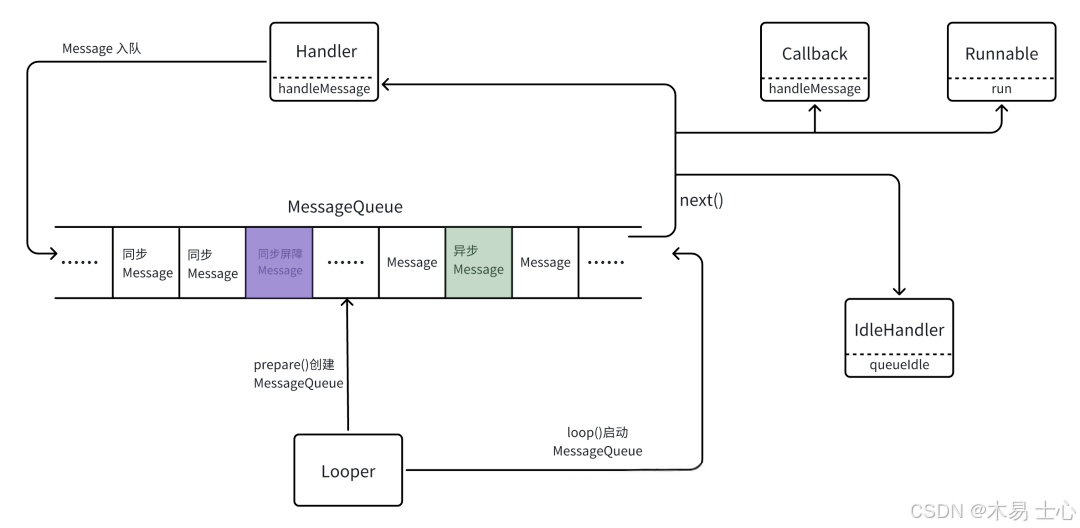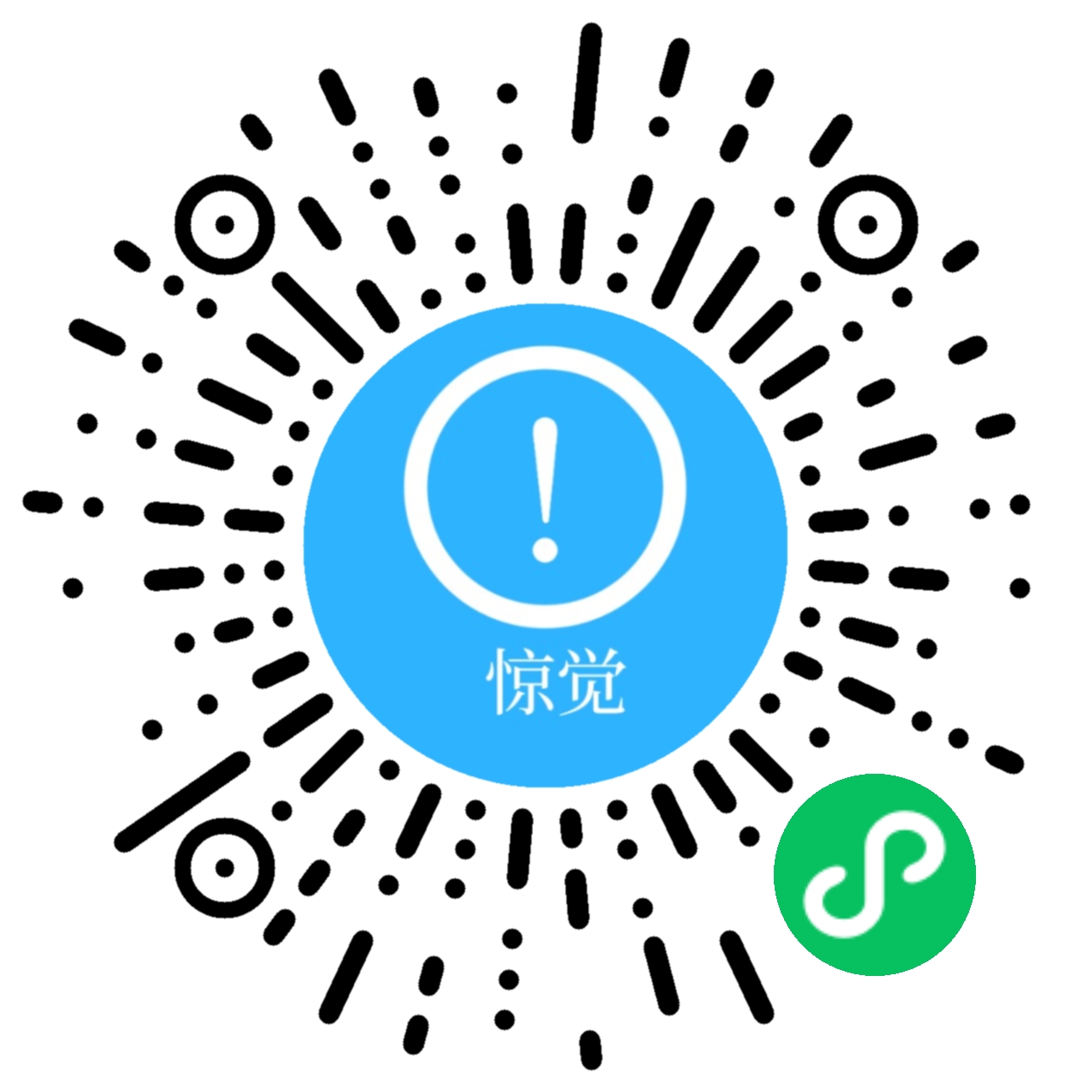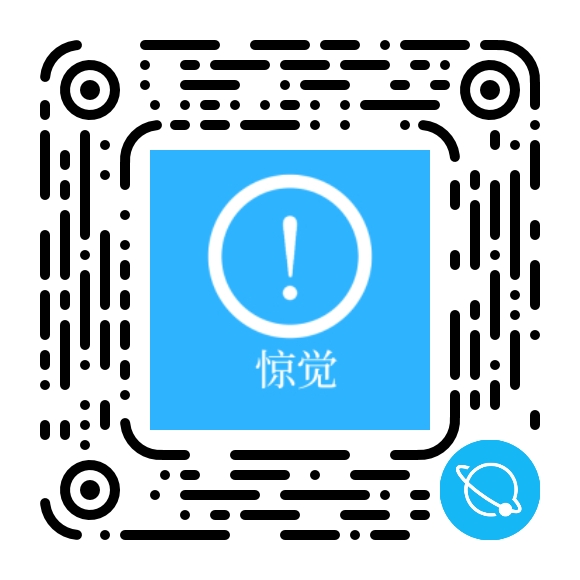一、 概述
Handler 机制是 Android 系统中实现**线程间通信(Inter-thread Communication)**的核心机制,尤其广泛用于将子线程中的任务结果传递回主线程(UI线程)进行更新操作。其底层基于 消息队列(MessageQueue) 和 循环器(Looper) 构建,形成一个典型的生产者-消费者模型。
该机制的核心目标是:
- 实现跨线程的消息传递
- 避免多线程并发修改 UI
- 提供延迟执行和定时任务的能力
- 支持异步任务调度与回调处理
二、 核心组件
1. Handler(处理器)
Handler 是开发者最常接触的类,负责:
- 发送消息:
sendMessage()、post()等方法 - 处理消息:通过重写
handleMessage(Message msg)或设置Callback - 与特定线程的
Looper和MessageQueue绑定
⚠️ 每个
Handler必须关联一个Looper,否则会抛出异常。
// 示例:创建 Handler 并绑定当前线程的 Looper
Handler handler = new Handler(Looper.myLooper()) {
@Override
public void handleMessage(@NonNull Message msg) {
// 在指定线程中处理消息
}
};
2. MessageQueue(消息队列)
MessageQueue 是一个按时间排序的消息队列,内部使用单向链表结构存储待处理的消息。
主要职责:
- 存储由
Handler发送的Message - 按
Message.when(执行时间戳)排序插入 - 提供
next()方法供Looper取出下一条可执行消息 - 支持阻塞等待(无消息时休眠,有消息时唤醒)
💡
MessageQueue并非传统 FIFO 队列,而是根据执行时间排序的优先队列。
3. Looper(循环器)
Looper 是消息循环的驱动者,每个线程最多只能有一个 Looper。
关键功能:
- 调用
Looper.prepare()初始化当前线程的Looper - 调用
Looper.loop()启动无限循环,不断从MessageQueue取出消息并分发 - 使用
ThreadLocal保证线程局部性
// 主线程中系统自动调用
Looper.prepareMainLooper(); // 初始化主线程 Looper
...
Looper.loop(); // 开始循环
4. Message(消息)
Message 是消息的载体,包含以下核心字段:
| 字段 | 说明 |
|---|---|
what | 用户自定义消息类型 |
arg1, arg2 | 整型参数,用于传递简单数据 |
obj | 任意对象(注意内存泄漏风险) |
target | 目标 Handler,由 Handler.sendMessage() 自动设置 |
callback | 如果是 post(Runnable),则 Runnable 封装为 callback |
when | 消息应被执行的时间戳(毫秒) |
next | 指向链表中的下一个 Message |
推荐使用
Message.obtain()获取实例,避免频繁创建对象。
三、工作原理
1. 整体流程图

2. 详细执行过程
1. 初始化 Looper(子线程示例)
在非主线程中若要使用 Handler,必须手动创建 Looper。
class WorkerThread extends Thread {
public Handler handler;
@Override
public void run() {
Looper.prepare(); // 创建当前线程的 Looper 和 MessageQueue
handler = new Handler(Looper.myLooper()) {
@Override
public void handleMessage(@NonNull Message msg) {
switch (msg.what) {
case 1:
Log.d("Handler", "收到消息: " + msg.obj);
break;
}
}
};
Looper.loop(); // 开始无限循环读取消息
}
public void quit() {
if (handler != null) {
handler.getLooper().quit(); // 安全退出循环
}
}
}
📌 注意:
Looper.prepare()只能调用一次,否则抛出RuntimeExceptionLooper.loop()是阻塞方法,直到调用quit()才退出
2. 消息发送机制
Handler 提供多种发送消息的方式:
| 方法 | 说明 |
|---|---|
sendEmptyMessage(int what) | 发送空消息 |
sendMessage(Message msg) | 发送自定义消息 |
post(Runnable r) | 发送 Runnable 任务 |
sendEmptyMessageDelayed(what, delay) | 延迟发送 |
postDelayed(Runnable r, long delayMillis) | 延迟执行 Runnable |
底层均调用 enqueueMessage() 将消息插入 MessageQueue。
// 示例:多种发送方式
handler.sendEmptyMessage(1);
Message msg = Message.obtain();
msg.what = 2;
msg.obj = "Hello";
handler.sendMessage(msg);
handler.post(() -> {
Log.d("Handler", "Runnable 执行");
});
handler.postDelayed(() -> {
Log.d("Handler", "1秒后执行");
}, 1000);
3. 消息处理流程
Handler.dispatchMessage() 是消息分发的核心逻辑:
public void dispatchMessage(@NonNull Message msg) {
if (msg.callback != null) {
// 优先处理 post(Runnable) 类型的消息
handleCallback(msg);
} else {
if (mCallback != null) {
// 其次交给 Handler 的 Callback 处理
if (mCallback.handleMessage(msg)) {
return;
}
}
// 最终调用 handleMessage
handleMessage(msg);
}
}
private void handleCallback(Message message) {
message.callback.run(); // 直接执行 Runnable
}
执行顺序:
Runnable>Callback>handleMessage
四、源码分析(精简版)
1. Looper 核心实现
public final class Looper {
static final ThreadLocal<Looper> sThreadLocal = new ThreadLocal<>();
final MessageQueue mQueue;
final Thread mThread;
private Looper(boolean quitAllowed) {
mQueue = new MessageQueue(quitAllowed);
mThread = Thread.currentThread();
}
// 准备 Looper
public static void prepare() {
prepare(true);
}
private static void prepare(boolean quitAllowed) {
if (sThreadLocal.get() != null) {
throw new RuntimeException("Only one Looper may be created per thread");
}
sThreadLocal.set(new Looper(quitAllowed));
}
// 获取当前线程的 Looper
public static @Nullable Looper myLooper() {
return sThreadLocal.get();
}
// 消息循环主方法
public static void loop() {
final Looper me = myLooper();
if (me == null) {
throw new RuntimeException("No Looper; Looper.prepare() wasn't called on this thread.");
}
final MessageQueue queue = me.mQueue;
for (;;) {
Message msg = queue.next(); // 可能阻塞
if (msg == null) return; // 退出循环
// 分发消息
try {
msg.target.dispatchMessage(msg);
} finally {
// 空实现,预留钩子
}
msg.recycleUnchecked(); // 回收消息
}
}
}
🔍 关键点:
ThreadLocal保证每个线程独享一个Looperloop()是死循环,通过queue.next()阻塞等待消息msg.target即发送该消息的Handler
2. MessageQueue 关键方法
enqueueMessage() —— 入队
boolean enqueueMessage(Message msg, long when) {
synchronized (this) {
if (msg.target == null) {
throw new IllegalArgumentException("Message must have a target.");
}
final long now = SystemClock.uptimeMillis();
msg.when = when;
Message p = mMessages; // 链表头节点
if (p == null || when == 0 || when < p.when) {
// 插入头部
msg.next = p;
mMessages = msg;
} else {
// 按时间顺序插入中间
Message prev;
for (;;) {
prev = p;
p = p.next;
if (p == null || when < p.when) {
break;
}
}
msg.next = p;
prev.next = msg;
}
// 唤醒消息队列(如果之前处于等待状态)
notify();
}
return true;
}
next() —— 出队(核心阻塞方法)
Message next() {
final long ptr = mPtr;
if (ptr == 0) return null; // 已退出
long pendingIdleHandlerCount = -1;
long nextPollTimeoutMillis = 0;
for (;;) {
// 阻塞等待,timeout 为 0 表示无限等待
nativePollOnce(ptr, nextPollTimeoutMillis);
synchronized (this) {
final long now = SystemClock.uptimeMillis();
Message prevMsg = null;
Message msg = mMessages;
// 同步屏障处理:跳过同步消息,只处理异步消息
if (msg != null && msg.target == null) {
do {
prevMsg = msg;
msg = msg.next;
} while (msg != null && !msg.isAsynchronous());
}
if (msg != null) {
if (now < msg.when) {
// 未到执行时间,计算等待时间
nextPollTimeoutMillis = (int) Math.min(msg.when - now, Integer.MAX_VALUE);
} else {
// 可执行,取出消息
if (prevMsg != null) {
prevMsg.next = msg.next;
} else {
mMessages = msg.next;
}
msg.next = null;
msg.markInUse();
return msg;
}
} else {
// 无消息,无限等待
nextPollTimeoutMillis = -1;
}
// 处理 IdleHandler(空闲时执行)
if (pendingIdleHandlerCount < 0 && (mMessages == null || now < mMessages.when)) {
pendingIdleHandlerCount = mIdleHandlers.size();
}
if (pendingIdleHandlerCount > 0) {
// 执行空闲任务
}
}
}
}
五、高级特性
1. 同步屏障(Sync Barrier)
用于优先处理异步消息(如 UI 绘制),屏蔽同步消息。
应用场景:
ViewRootImpl请求重绘时插入屏障,确保Choreographer的VSYNC消息优先执行
// 插入同步屏障
int token = mHandler.getLooper().getQueue().postSyncBarrier();
// 移除屏障
mHandler.getLooper().getQueue().removeSyncBarrier(token);
⚠️ 滥用可能导致同步消息饥饿,不建议普通应用使用。
2. 空闲处理器(IdleHandler)
当 MessageQueue 没有消息需要处理时,会回调 IdleHandler,可用于执行低优先级任务。
Looper.myQueue().addIdleHandler(new MessageQueue.IdleHandler() {
@Override
public boolean queueIdle() {
Log.d("IdleHandler", "消息队列空闲,执行预加载");
// 返回 true:保持注册;false:执行一次后移除
return false;
}
});
典型用途:
- 延迟初始化组件
- 预加载数据
- 执行非关键任务以提升流畅度
3. 异步消息(Asynchronous Message)
避免被同步屏障阻塞,适用于高优先级任务。
Message msg = Message.obtain(handler, runnable);
msg.setAsynchronous(true);
handler.sendMessageAtTime(msg, SystemClock.uptimeMillis() + 1000);
Handler.createAsync()可创建专门处理异步消息的Handler
六、内存优化机制
1. Message 对象池(对象复用)
为减少频繁创建/销毁对象带来的 GC 压力,Message 内部维护了一个对象池。
public final class Message implements Parcelable {
private static final int MAX_POOL_SIZE = 50;
private static Message sPool;
private static int sPoolSize = 0;
private static final Object sPoolSync = new Object();
public static Message obtain() {
synchronized (sPoolSync) {
if (sPool != null) {
Message m = sPool;
sPool = m.next;
m.next = null;
m.flags = 0;
sPoolSize--;
return m;
}
}
return new Message();
}
public void recycle() {
if (isInUse()) return;
recycleUnchecked();
}
void recycleUnchecked() {
flags = FLAG_IN_USE;
what = 0;
arg1 = 0;
arg2 = 0;
obj = null;
target = null;
callback = null;
data = null;
when = 0;
synchronized (sPoolSync) {
if (sPoolSize < MAX_POOL_SIZE) {
next = sPool;
sPool = this;
sPoolSize++;
}
}
}
}
建议始终使用
Message.obtain()而非new Message()
七、 使用注意事项
1. 避免内存泄漏
常见场景:非静态内部类 Handler 持有外部 Activity 引用,导致无法回收。
解决方案:静态内部类 + 弱引用
private static class SafeHandler extends Handler {
private final WeakReference<MainActivity> mActivity;
public SafeHandler(MainActivity activity) {
mActivity = new WeakReference<>(activity);
}
@Override
public void handleMessage(@NonNull Message msg) {
MainActivity activity = mActivity.get();
if (activity == null || activity.isFinishing() || activity.isDestroyed()) {
return;
}
switch (msg.what) {
case 1:
activity.updateUI((String) msg.obj);
break;
}
}
}
或使用 WeakHandler(第三方库)
// 如 Square 的 LeakCanary 推荐方式
WeakHandler weakHandler = new WeakHandler(this, new Handler.Callback() {
@Override
public boolean handleMessage(@NonNull Message msg) {
// 安全处理
return true;
}
});
2. 正确退出 Looper
在子线程中使用 Looper 后,应在适当时机退出,避免资源浪费。
// 安全退出:处理完已到时的消息再退出
handler.getLooper().quitSafely();
// 立即退出:丢弃所有未处理消息
handler.getLooper().quit();
建议在
Thread的onDestroy或quit()方法中调用
3. 主线程 vs 子线程
| 线程类型 | Looper 是否自动创建 | 使用方式 |
|---|---|---|
| 主线程(UI线程) | 是(系统自动调用 Looper.prepareMainLooper()) | 直接创建 Handler |
| 子线程 | 否 | 必须手动调用 Looper.prepare() 和 Looper.loop() |
八、常见问题与使用建议
| 问题 | 解决方案 |
|---|---|
Can't create handler inside thread that has not called Looper.prepare() | 在子线程中先调用 Looper.prepare() |
| 内存泄漏 | 使用静态 Handler + WeakReference |
| 消息延迟不准 | 系统休眠或高负载可能导致延迟,不保证精确时间 |
| 大量消息堆积 | 控制消息频率,避免 OOM |
使用 postDelayed 实现轮询 | 不推荐,应使用 AlarmManager 或 WorkManager 替代 |
九、总结
Android 的 Handler 机制是一个精巧的线程通信架构,其设计体现了以下几个关键思想:
| 组件 | 角色 | 设计亮点 |
|---|---|---|
Handler | 消息生产者与消费者 | 提供易用的 API |
MessageQueue | 消息存储与调度 | 单链表 + 时间排序 + 阻塞唤醒机制 |
Looper | 消息循环驱动 | ThreadLocal + 无限循环 |
Message | 消息载体 | 对象池复用 + 多种数据承载方式 |
1.核心优势
- 线程安全:保证 UI 更新在主线程完成
- 异步解耦:任务可在任意线程发起,在指定线程执行
- 延迟执行:支持定时任务和延迟操作
- 内存高效:
Message对象池减少 GC 压力 - 扩展性强:支持同步屏障、空闲处理器等高级特性
2.应用场景
- 子线程更新 UI
- 延迟操作(如启动页倒计时)
- 定时任务(需结合
removeCallbacks防止泄漏) - 线程间状态同步
💡 尽管现代 Android 开发越来越多地使用
Coroutine、LiveData、RxJava等替代方案,但Handler仍是底层基石,理解其原理有助于深入掌握 Android 消息机制。
转载自CSDN-专业IT技术社区
原文链接:https://blog.csdn.net/csdn_silent/article/details/153244375



